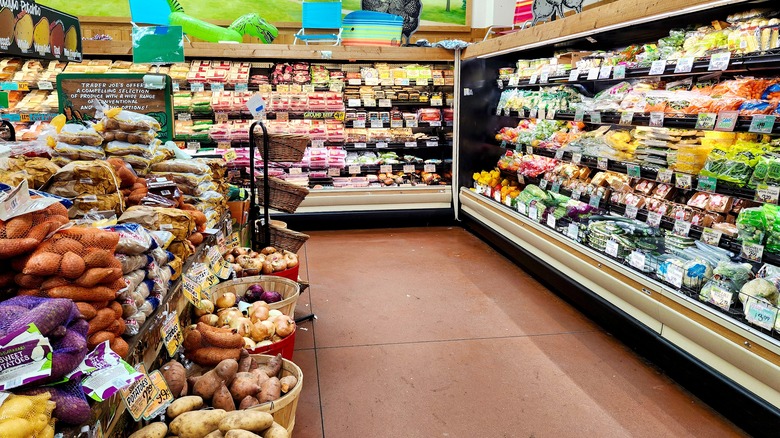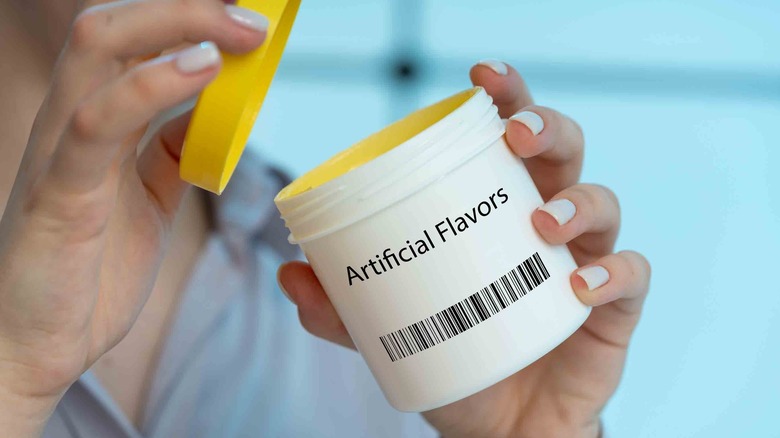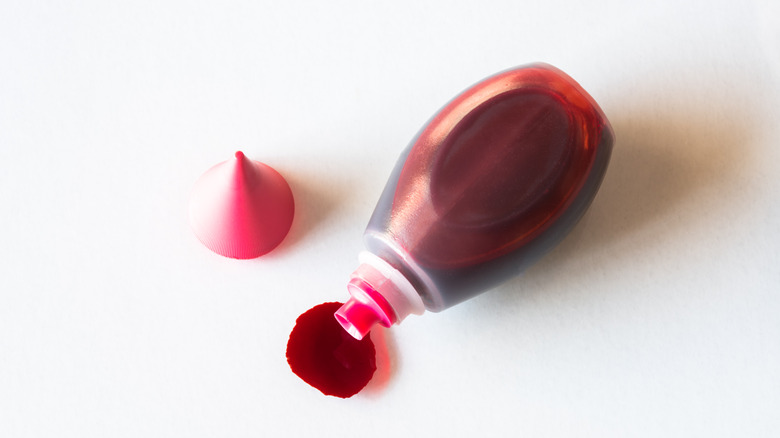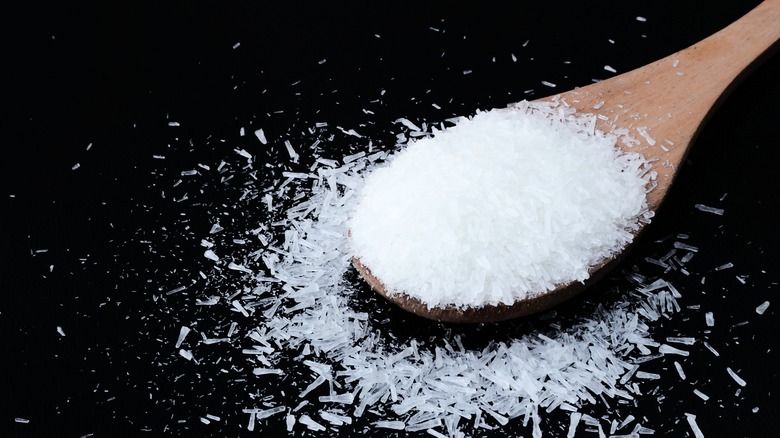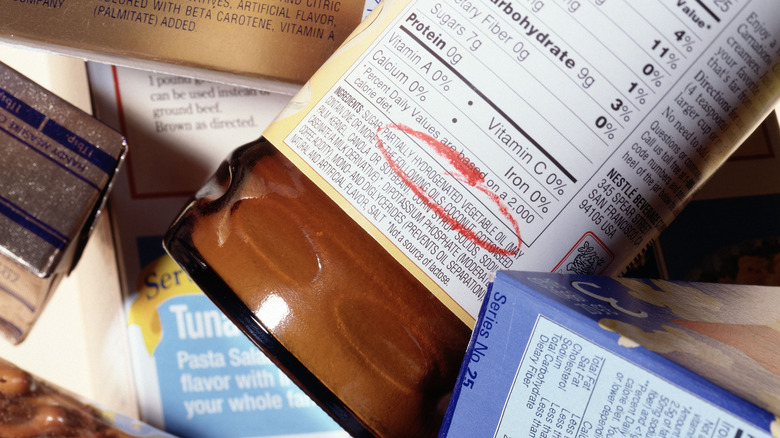Trader Joe's Never Adds These 7 Ingredients To Its Products
It's a beautiful Saturday afternoon, and it's time for your weekly trip to the grocery store. At the top of your grocery list are dried mangoes, cookie butter, and bananas for a loaf of banana bread you plan to make next week. While you can pick up these ingredients at any grocery store, only one has perfectly sweetened dried mangoes and the cheapest bananas around, and that is Trader Joe's (you've gotta love those banana prices).
Despite the minor inconveniences of tiny parking lots and over-crowded aisles, that seem to plague every Trader Joe's in America – that exists in every state except eight — Trader Joe's remains a favorite for its reasonable prices, unique items, and mindful selection of products. The brand has a passionate following that appreciates the company's commitment to providing top-notch items while keeping prices as affordable as possible. Trader Joe's doesn't stop with fun food and great value, though. While other grocery store chains stock their stores with an abundance of products and seemingly little attention to ingredients, Trader Joe's closely examines ingredients before adding a new product to its inventory.
Trader Joe's consumers are ingredient-savvy and demand products that align with their values, and the grocery store does a great job of giving people what they want. No matter your stance on additives in processed food, you can be guaranteed your Trader Joe's purchases will never include these unhealthy or questionable ingredients.
Artificial flavors
Trader Joe's never uses artificial flavors in its products. Artificial flavors, sometimes called synthetic flavors, are created by combining lab-manufactured chemicals to get the desired flavor. A good example of this is imitation vanilla, which contains vanillin. Many people would be surprised to know that most vanillin is sourced from petroleum. However, it's important to note that the FDA heavily regulates the use of artificial flavors, and in order to be included in food, it needs to be recognized by the FDA as GRAS (an acronym for Generally Recognized As Safe). Natural flavors, on the other hand, always come from a natural source, such as plants, fruits, spices, and even bark. The government regulates natural flavors and holds them to high standards, too.
Natural flavors can be more expensive and labor-intensive to procure, and it can be challenging to maintain a consistent flavor profile when using flavors that are sourced from natural ingredients. However, Trader Joe's foregoes synthetic flavors entirely, opting for only natural flavors, like in its lauded Green Tea Yuzu spread (which can be used for sweet and savory items).
Artificial preservatives
People have been preserving food since 12,000 B.C., but "preservatives" has become a bad word in recent decades. Trader Joe's, however, only uses natural preservatives in its food. While food back in the old days had to be preserved with natural processes like drying, curing, or pickling, methods of preserving food have changed drastically over the years. Today, we often rely on chemical-based preservatives that are manufactured specifically to keep our food fresh.
One example of an artificial preservative is sodium benzoate, a lab-manufactured chemical that can give some products a shelf life of two years. Artificial preservatives are deemed safe in their recommended amounts. Still, they can include ingredients that have been linked to asthma, allergies, and even cancers, making some people wary of having them in their diet. Just like their flavor counterparts, artificial preservatives are easier and less expensive to create, making them popular in today's processed foods. However, every item on your Trader Joe's shopping list is free of artificial preservatives. And when Trader Joe's does have to use preservatives, as in the case of adding naturally-occurring sulfur dioxide to its dried fruit, the company is transparent and makes sure it's easy to identify on the label.
Synthetic colors
Like flavors and preservatives, food coloring is available in natural and synthetic forms. Trader Joe's refuses to use synthetic colors and only uses colors that are sourced from plants and minerals. Natural food coloring can come from many sources, but Trader Joe's uses beets, turmeric, and paprika as a few examples of where its food coloring begins.
Synthetic colors can be produced in large quantities significantly cheaper than natural ones (you probably see a theme by now — using artificial ingredients is quicker, cheaper, and easier than creating those same ingredients from natural sources). Synthetic colors also have a longer shelf-life, which makes them appealing to manufacturers who want to extend every dollar they spend to maximize their returns. Many food dyes in today's processed foods come from petroleum or crude oil. But you won't find any of that in your favorite foods from Trader Joe's. Even when you choose the more unhealthy items at Trader Joe's, you can rest assured they are colored with natural food coloring. So enjoy those colorful Trader Joe's Instant Boba kits, knowing they're only made with natural colors (and flavors!).
MSG
MSG (monosodium glutamate) has been through the wringer these last few decades. Once a popular ingredient that has since been shunned, it's slowly returning to the good graces of consumers and restaurant-goers. Despite the public's misunderstanding of this ingredient, Trader Joe's plays it safe and does not use MSG in any of its products.
This controversial ingredient was first introduced to the public in 1907 when a Japanese chemist named Kikunae Ikeda extracted a granular substance from boiled-down seaweed. This substance, called glutamate, has a savory flavor that enhances many recipes (and a quick side note — we can also thank the inventor of MSG for the word umami). In 1968, a doctor was concerned that MSG, sodium, and wine used for cooking were making him feel bad. He published a letter in a medical journey with his assumptions, and it quickly took root in society that MSG was harmful (cooking wine and salt do not appear to have suffered the same fate). And to be fair, some people do react negatively to MSG. While MSG is having a comeback (backed by science), it's still up for debate among the general population about whether or not it's an acceptable ingredient. Time will tell if this ingredient is back for good, but for now, home chefs unwilling to bring MSG into their kitchen can find the same savory flavor by using beef broth.
Genetically modified ingredients
Trader Joe's listens to its customers and knows customers don't want GMOs in their food. You won't find genetically modified ingredients in Trader Joe's products. Another controversial buzzword, GMO stands for genetically modified organism. Today, GMOs make up some of America's most prevalent crops, including corn, soybeans, and potatoes. While we can thank GMOs for saving the papaya, many people are uncomfortable eating food that has been genetically modified or contains genetically modified ingredients.
Trader Joe's requires all of its suppliers to produce documentation that their products do not include GMOs. This even applies to the meat sold at Trader Joe's — the animals are not allowed to be fed with feed derived from GMO ingredients. While you won't find Non-GMO labels on the company's products, that's not because the products include GMOs. It's simply because there isn't a clear, government-sanctioned certification program for non-GMO products at this time. Instead, Trader Joe's does its due diligence in bringing you non-GMO products. But take note — while you can be confident that all the products wearing a Trader Joe's label are non-GMO, the store doesn't guarantee the same for any of the brand-name products it sells. Consumers must research the brands Trader Joe's brings into the store.
Partially hydrogenated oils (artificial trans fats)
Partially Hydrogenated oils, or trans fats, are an inexpensive way to give processed foods a long shelf life. This preservative, however, is terrible for heart health — and Trader Joe's never uses it in any of its products. Trans fats have been linked to high cholesterol, heart attacks, and risk of stroke. They are so dangerous that in 2015, they were banned as an ingredient in the United States. That doesn't mean they've completely disappeared, though. Small amounts of trans fats can still be added to your processed foods (manufacturers can include up to half a gram of trans fats per serving of food), and those amounts can add up. Just think about the last time you grabbed a box of crackers or a bag of chips and only ate the recommended serving. You could potentially be eating quite a bit of trans fats if you aren't diligently tracking your food (and who has time for that?).
Trans fats used to be a prominent ingredient in popular foods, but Trader Joe's doesn't accept them in any form or fashion in the products it sells. However, it's important to note that while many countries, including the U.S., have banned partially hydrogenated oils, others have not. Be sure to read all nutritional labels and check the ingredients on foods manufactured in other countries to avoid trans fats entirely in your diet.
BPA
While not technically a food ingredient, BPA, or bisphenol A, is a chemical used for decades to strengthen plastic (it used to be common in baby bottles and food storage containers). Trader Joe's does include some BPA in their packaging, but they guarantee it never comes into contact with the food it's protecting. BPA has come under fire in recent years for being dangerous when heat causes the chemical to leach into the food we eat, making it of particular concern for plastics that are designed to be microwaved or heated up in any way. Many of today's plastic products avoid BPA, which has been linked to infertility, diabetes, and obesity.
Trader Joe's uses BPA-free packaging, with the exception of one thing — the metal lids on its glass jars. The lids include a layer of BPA, but they're coated in another layer of food-safe material to ensure that the BPA does not touch or leak into the food in the jar. Trader Joe's doesn't say why the lids include BPA, but it says multiple sources have tested them to confirm that no BPA has been identified from the lids.
